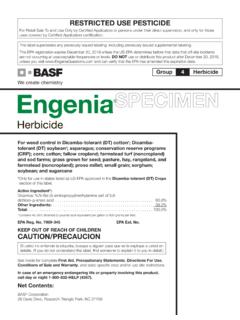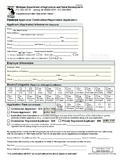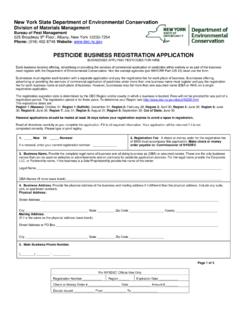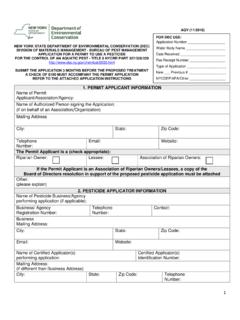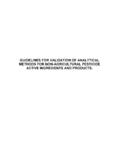Transcription of Guidelines for the registration of microbial, …
1 International Code of Conduct on Pesticide Management Guidelines for the registration of microbial, botanical and semiochemical pest control agents for plant protection and public health uses International Code of Conduct on Pesticide Management Guidelines for the registration of microbial, botanical and semiochemical pest control agents for plant protection and public health uses Food and Agriculture Organization of the United Nations World Health Organization Rome, 2017 The designations employed and the presentation of material in this publication do not imply the expression of any opinion whatsoever on the part of the Food and Agriculture Organization of the United Nations (FAO) or of the World Health Organization (WHO) concerning the legal status of any country, territory, city or area or of its authorities, or concerning the delimitation of its frontiers or boundaries.
2 Dotted lines on maps represent approximate border lines for which there may not yet be full agreement. The mention of specific companies or products of manufacturers, whether or not these have been patented, does not imply that these are or have been endorsed or recommended by FAO or WHO in preference to others of a similar nature that are not mentioned. Errors and omissions excepted, the names of proprietary products are distinguished by initial capital letters. All reasonable precautions have been taken by FAO and WHO to verify the information contained in this publication. However, the published material is being distributed without warranty of any kind, either expressed or implied.
3 The responsibility for the interpretation and use of the material lies with the reader. In no event shall FAO and WHO be liable for damages arising from its use. The views expressed herein are those of the authors and do not necessarily represent those of FAO or WHO. ISBN 978-92-5-130015-2 (FAO) FAO and WHO, 2017 FAO and WHO encourage the use, reproduction and dissemination of material in this information product. Except where otherwise indicated, material may be copied, downloaded and printed for private study, research and teaching purposes, provided that appropriate acknowledgement of FAO and WHO as the source and copyright holder is given and that FAO and WHO s endorsement of users views, products or services is not implied in any way.
4 All requests for translation and adaptation rights, and for resale and other commercial use rights should be made via or addressed to FAO information products are available on the FAO website ( ) and can be purchased through publication was developed in the context of the Inter-Organisation Programme for the Sound Management of Chemicals (IOMC). The IOMC was established in 1995 following recommendations made by the 1992 UN Conference on Environment and Development to strengthen cooperation and increase international coordination in the field of chemical safety. The participating organizations are the Food and Agriculture Organization of the United Nations (FAO), the International Labour Organization (ILO), the Organisation for Economic Co-operation and Development (OECD), the United Nations Environment Programme (UNEP), the United Nations Industrial Development Organization (UNIDO), the United Nations Institute for Training and Research (UNITAR), the World Health Organization (WHO), the World Bank and the United Nations Development Programme (UNDP).
5 The purpose of the IOMC is to promote coordination of the policies and activities pursued by the participating organizations, jointly or separately, to achieve the sound management of chemicals in relation to human health and the environment. The contents of this publication do not necessarily reflect the views or stated policies of individual IOMC participating organizations. iii Contents FOREWORD .. v ABBREVIATIONS .. vi DEFINITIONS .. vii 1. INTRODUCTION .. 1 International crop protection context .. 1 Objectives .. 2 Scope .. 2 Factors specific to biological pest control agents to be considered .. 3 Biological control agent specific registration 4 2.
6 MICROBIALS .. 6 Definitions .. 6 Types of data and information (data requirements) .. 9 Evaluation of the dossier .. 15 3. BOTANICALS .. 22 Definitions .. 22 Types of data and information (data requirements) .. 23 Evaluation of the dossier .. 30 4. SEMIOCHEMICALS .. 37 Definitions .. 37 Data requirements for registration of semiochemicals .. 37 Evaluation of the dossier .. 45 Annex 1: Data requirements for registration of microbials .. 48 A. Microbial pesticides : recommended data requirements for registration of the active substance (MPCA) .. 48 B. Microbial pesticides : recommended data requirements for registration of the formulated products (MPCP).
7 61 Annex 2: References and 72 iv v FOREWORD These Guidelines are intended to guide pesticide regulatory authorities in the registration of microbial, botanical, and semiochemical pest control agents for plant protection and public health uses. The Guidelines update and replace the 1988 FAO publication The registration of Biological Pest Control Agents . In developing these revised international Guidelines , attention has been given to building on the original 1988 FAO publication and harmonizing with the current state-of-the-art information from other national and international sources such as the US Environmental Protection Agency (US EPA), the Organisation for Economic Co-operation and Development (OECD), and the European Union (EU).
8 In particular, these Guidelines were written in parallel with guidance on the registration of biological pesticides published by the OECD and the EU. For this reason, in some instances, these Guidelines use the same text in the guidance by these two organizations. In preparing and approving these Guidelines , the members of the FAO/WHO Joint Meeting on Pesticide Management (JMPM) have ensured that the guidance becomes most applicable to stakeholders in low and middle income countries while maintaining a high degree of harmonization with practices in other parts of the world. Permission to reprint the text has been granted by the OECD and the EU.
9 A bibliography with all relevant references can be found at the end of these Guidelines . FAO and WHO welcome readers feedback on the use of these Guidelines The JMPM members have put a lot of effort and consultation in developing this document. They however consider that this is a living document that could be further improved. They particularly value any feedback users of these Guidelines may have and would welcome any comment. Please send comments to by indicating the title of the Guidelines and the Chapter/section/page the comments are about. vi ABBREVIATIONS ADI Acceptable daily intake CFU Colony-forming unit EGBP Expert group on biopesticides (OECD)
10 EPPO European and Mediterranean Plant Protection Organization EU European Union EC European Commission FRAC Fungicide resistance action committee GAP Good agriculture practice GEP Good Experimental Practice GLP Good Laboratory Practice GMO Genetically modified organism GRAS Generally recognized as safe HPLC High performance liquid chromatography HRAC Herbicide resistance action committee IPM Integrated Pest Management IPPC International Plant Protection Convention IRAC Insecticide resistance action committee ISPM International Standards for Phytosanitary Measures IVM Integrated Vector Management MPCA Microbial pest control agent MPCP Microbial pest control product OECD Organisation for Economic Co-operation and Development PPE Personal protective equipment RNA Ribo-nucleic acid QA Quality assurance QC Quality control QPS Qualified presumption of safety QSAR Quantitative structure activity relationship models SCLP Straight chain lepidopteran pheromones SOP Standard operating procedure TDI Tolerable daily intake TGAS Technical grade active substance TTC Threshold of toxicological concern US EPA United States Environmental Protection Agency vii DEFINITIONS Active ingredient.











